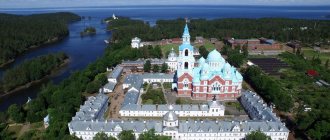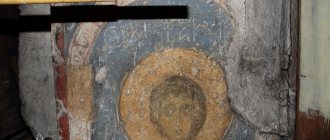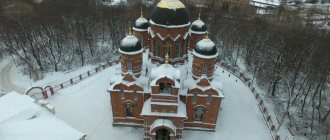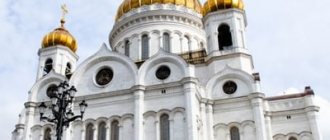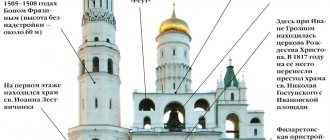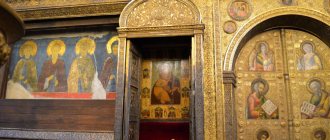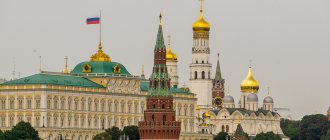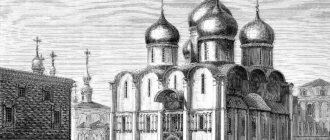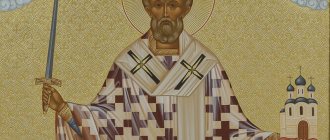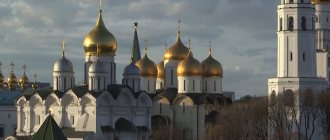The future saint was born into a family of simple peasants in the middle of the 16th century. The parents of Alexander Svirsky were childless for a long time and asked God for an heir, so they named their long-awaited son Amos, in honor of one of the biblical prophets. From childhood, Amos showed an interest in prayer and the study of theology. At the age of twelve, the young man declared that he wanted to devote his life to serving God and take monastic vows. This news greatly upset his parents: their only son deprived them of the happiness of babysitting their grandchildren. And so, at the age of twelve, in defiance of his elderly father and mother, Amos took monastic vows, receiving the Orthodox name Alexander, and secretly went to Valaam. The young man did not know the way to the city, he simply wandered away from his father’s house. But the angels who appeared to him showed young Amos the way.
He spent seven years in humble service to God. After this time, the face of the Trinity appeared to the saint. Before this, only Abraham had seen God in all three of his faces. Alexander's conversation with God was about how to gather the brethren and about the construction of the temple. The saint devoted many years to the construction and decoration of the temple, erected in the place that the Trinity showed him. We are talking about the Trinity Monastery, the most beautiful cathedral in Rus'. Enormous funds and efforts were allocated for the construction of this temple; many people: from trained builders to clergy and ordinary believers - worked on the construction of the temple and brought donations.
Life
The Monk Alexander of Svirsky (in the world - Amos) was born on June 15, 1448 in the village of Mandera (Sermaxa), not far from Lake Ladoga. The family of simple peasants was a believer, and therefore Christian values were brought up in the boy from childhood.
At the age of 19, the young man, secretly from his parents, went to Valaam, where he lived for the next seven years as a novice. In 1474 Amos was tonsured a monk with the name Alexander. Taking upon himself the monastic feat of solitude, he went to live in a cave on the island, later called Saint. There he remained in tireless prayer and hard work for about seven years.
In 1485, the monk was blessed by the abbot of the monastery to live near the Holy Lake, located near the small town of Olonets. Later, a monastery was built on this spot, named after the saint. In 1504, with the blessing of the Novgorod Archbishop Serapion, Alexander Svirsky was installed as abbot of the Trinity Monastery (later the Alexander-Svirsky Monastery).
The life of the Monk Alexander was full of righteous miracles. However, the most important event was the appearance of the Holy Trinity to him, given to him over many years of tireless service to God. From a conversation with the Lord, who appeared before His saint in Three Persons, he learned how to build a monastery and gather the brethren. And then I just acted according to God’s instructions.
The Monk Alexander died on August 30 (new style) 1533.
Venerable Alexander Svirsky. Icon Photo from the site hram-troicy.prihod.ru
Evidence of Divine Power
Miracles occurring from the icon of Alexander Svirsky were observed by many people, and the monks scrupulously recorded the testimony of believers.
- The holy image saved parishioners from cancerous tumors, some people regained their sight after blindness and gained mobility of their limbs after paralysis. The weak, humbly asking the divine face, received strength and a healthy nervous system, and after a while they came to the temple on their own and thanked for the miraculous deliverance.
- Often the monk appeared in a dream to people wishing to take monastic vows, and directed them along a completely different path.
- The images of the saint, located in the iconostases of some people, began to stream myrrh.
- Miracles occurred during the elder’s lifetime. At the beginning of the 16th century, his cell was illuminated with bright light, and three angels in snow-white robes appeared before Alexander’s eyes. After some time, the Church of the Holy Trinity was erected here.
- One day the Mother of God appeared to him, and in honor of this event it was decided to build a monastery, which is now completely destroyed. The Virgin Mary promised to help in the creation of the temple and everyone living in it.
- Despite the large number of encounters with divine creatures, the Monk Alexander remained a humble servant of God and sought to help everyone who asked for protection.
- The day before his death, the holy elder gathered his devoted brethren around him, blessed those who came and announced that he was leaving this mortal world for eternal life in the abode of the Almighty.
Appearance of the Trinity to Alexander Svirsky
The history of the discovery of the relics and the canonization of the saint
Alexander Svirsky became one of the few saints whose canonization was carried out quite quickly after his death. Namely - 14 years later, in 1547 at the Makaryevsky Cathedral. Historians are inclined to believe that this was largely due to the important victory for the Russian army over the Kazan prince Epancha, which miraculously fell on the day of veneration of the saint.
The relics were found in April 1641, incorrupt. What became another greatest miracle of the Monk Saint Svirsky. After the discovery of such a valuable Orthodox shrine, people from different parts of Russia rushed to the sacred shrine, eager to touch their beloved saint and pray to him.
However, since 1918, this Christian shrine was destined to go through many tests. Having been taken out of the temple by the Bolshevik commissars, the remains of Alexander Svirsky were first subjected to a thorough examination. Imagine the surprise of the scientists who discovered that the holy relics were really real, and not, as they assumed, a “wax doll.” Having learned about this, the political leadership ordered to hide the body of the saint so that no one would ever find it. For this purpose, it was transferred as a biological exhibit to the museum of the Military Medical Academy named after. Kirov.
It is not known what the fate of the relics would have been, however, with God’s help, the head of the department of normal anatomy, Academician Tonkov, together with his students, took the shrine under his protection. Coming from an intelligent, religious family, he managed to find out what kind of rare “exhibit” was kept at the academy and did everything possible to save it from destruction.
In 1997, nun Leonida became the organizer of the search for the holy relics of St. Alexander of Svirsky. Having done a lot of work, she, fortunately, was able to find his relics. More medical and historical examinations followed. And finally, in 1998, the incorrupt remains were returned to the Church and reopened to all believers.
Troparion, kontakion, magnification
Troparion to St. Alexander of Svirsky, tone 4:
From youth, God-wise, with spiritual desires I moved into the desert, / I desired to follow the steps of the one and only Christ, / in the same way, I did the same with the angels, seeing you, marveling, / how with the flesh you labored in invisible wiles, the wise one , / you conquered the armies of passions by abstinence / and you appeared equal to the angel on earth, / Reverend Alexandra, / pray to Christ God, // that he may save our souls.
Kontakion, tone 8:
Like a multi-bright star / today you have shone in the Russian countries, father, / having settled in the desert, / you have zealously desired to follow Christ’s footsteps / and the holy cross has lifted the holy yoke upon your frame, / you have put to death the labors of your bodily leaps. / In the same way we cry to you: / save your flock, which you have gathered, O wise man, let us call to you: // Rejoice, our Father Alexandra.
Greatness
We bless you, / Reverend Father Alexandra, / and honor your holy memory, / mentor of monks, // and interlocutor of angels.
Location of the relics of St. Alexander Svirsky
The relics of the saint are kept in the Holy Trinity Alexander-Svirsky Monastery in the Leningrad Region. The monastery, once founded by the righteous Alexander, was in desolation and ruin during the reign of the godless Soviet regime, and was used for many years for other purposes (either as a nursing home, or as a technical school, or as a hospital for the mentally ill).
In 1997, the monastery began to be restored. And today the monastery happily welcomes everyone.
Holy Trinity Alexander-Svirsky Monastery Photo from the site svirskoe.ru
Icon “Alexander Svirsky in the Life” in the Assumption Cathedral of the Moscow Kremlin
Of all the hagiographic icons of the Assumption Cathedral in the Moscow Kremlin, I have long been attracted to the image of Alexander Svirsky. The icon is located in the northern wall iconostasis of the temple and is distinguished by a huge number of marks - as many as 129 of them! It is quite obvious that it makes no sense to include a detailed analysis of the icon of St. Alexander in the tour. It is very difficult to even see the marks, the writing is small, and the image hangs quite high from eye level.
But my own curiosity pushed me to examine the marks of the icon in detail. As a source for a short review, I chose the life of St. Alexander of Svirsky and some Internet sources, a list of which I will give below.
Table of contents
Veneration of Alexander Svirsky in Moscow
It is no coincidence that the image of this saint is located in the Moscow Assumption Cathedral. The celebration of St. Alexander's Day takes place twice a year: in April and on September 12 according to the new style. On the September day of memory of this saint (August 30, old style) in 1552, Ivan IV won an important victory in the Kazan campaign. The dedication of one of the churches of the Intercession Cathedral to St. Alexander of Svirsky is connected with this victory.
Life of St. Alexander of Svirsky
I do not set myself the goal of retelling the life of the saint; it is covered in detail on many resources (links at the end of the article). Let us remember that the monk lived in the second half of the 15th century (born in 1448) - the beginning of the 16th century in the north, on the border of the present Leningrad region and Karelia. At first he labored in a monastery on Valaam. He founded the Alexander-Svirsky Monastery, which is still active today. He became famous for many miracles, including the appearance of the Trinity. He lived a modest and righteous life, never disdained hard work, and lived alone in the desert for several years, eating only the gifts of nature. Saint Alexander of Svirsky died in 1533 at the age of 85. The Monk Alexander was canonized 14 years (!) after the presentation, so the life of the saint was compiled by people who knew and remembered him. Examining the marks of the icon, we will become more familiar with the deeds and miracles of St. Alexander of Svir.
Icon of Alexander Svirsky in his life with stamps
The image was painted between 1547 and 1552 in Moscow. The centerpiece of the icon is an image of St. Alexander of Svirsky. This is a half-length image of the monk, dressed in monastic robes. The high forehead is furrowed with deep wrinkles, the face is framed by short hair and a wide, bushy beard. In his left hand the saint holds a scroll with an inscription, and with his right hand he blesses it. (Black and white photographs hereinafter taken from the website “Christianity in Art”)
The centerpiece is surrounded by numerous marks; they can be divided into three levels. The top one is written above the image of the monk. On the middle one, the marks are located to the left and right of the image of the saint. The lower level is written under the middle. Each level has four registers (rows).
Marks of the icon Alexander Svirsky in his life
It is more logical to consider the marks from above. Determining which scene is located where is not difficult, because next to the icon in the Assumption Cathedral there is a label indicating the marks of the image.
Each register has 12 stamps, but in the last, fourth register of the top level, two scenes are combined in one left stamp. Thus, in the upper level there are not 48, but 49 marks.
The upper level of the stamps of the icon “Alexander Svirsky in the Life”
It is very difficult to visually identify individual marks of a miniature letter of the upper level in the insufficient lighting of the Assumption Cathedral. There is an image of the icon in T.V. Tolstoy’s book “The Assumption Cathedral,” but enlarging the image blurs and makes it impossible to see the marks.
Icon Alexander Svirsky in his life. First register. Stamps 1-12
1. Prayer of husband and wife for childbearing. According to life, the parents of St. Alexander Stefan and Vasilisa had older children, but they really wanted the Lord to send them a son. They prayed tirelessly for the sending of a child.
The future saint was born on the day of remembrance of the prophet Amos, and at baptism he was named after his heavenly patron.
To the left of the first mark we will see the scene of the birth of Amos. 2.Birth.
I will list the scenes of the first level, as they are given on the label in the Assumption Cathedral.
3-4.Baptism. Parents send the boy to school. 5. The youth prays in front of the icon of the Mother of God for help in his studies. 6-8. Meeting and conversation with the monks of the Valaam Monastery. 9. Saying goodbye to parents. 10. Overnight on the shore of the lake. 11. Prayer for sending the traveler to the monastery. 12. Amos miraculously finds a companion
Icon Alexander Svirsky in his life. Second register. Stamps 13-24
13. Travel to the Valaam Monastery with a miraculously found companion. Prayer in front of the monastery gates. 14-15. Taking monastic vows. Prayer before the icon. 16-22. Parents are looking for their son. Meeting of father and son. Father's tonsure. 23-24. Monastic works of the monk. Monk Alexander kneads dough and bakes bread,
(24.) carries water and firewood.
Third register. Stamps 25-36
25. Alexander sings psalms at night, he humiliates his flesh, exposing his body, mosquitoes bite into the flesh of the saint.
26-28. Monk Alexander asks the abbot to release him from the monastery.
Leaving the Valaam Monastery. 29-31. Monk Alexander builds a hut by the lake. 32-34. Appearance of an angel about the founding of the monastery. 35. Boyar Andrei Zavalishin, while hunting with his squad, chases a deer in the forest. 36. The deer runs to the top of the hill and leads the boyar behind him.
Fourth register. Brands 37-49
37-39. Andrei Zavalishin discovers a hermit's hut, meets the monk Alexander and talks with him. 40-42. The arrival of Ivan’s brother to Alexander. 43. Boyar Zavalishin comes to the Monk Alexander with his children and gifts. 44-46. The Monk Alexander cuts down trees; sows grain; distributes alms to the needy. 47-49. Visit to the monastery by Elder Nicephorus. The elder blesses Alexander to leave the monastery.
The average level of hallmarks of the icon “Alexander Svirsky in the Life”. Right side
The upper register ends with the 49th mark. After the upper case, the marks should be read to the right of the middle. There are a total of 16 marks in the middle right level.
This level seems to me the most important in the entire narrative. Here is depicted the appearance of the Trinity to the Monk Alexander. To the right of the middle level in the upper left corner of the middle level is the 50th mark.
First (upper) register of the middle level. Stamps 50-53
50. Intimidation of Alexander by demons. (Picture shows stamps 50 and 51).
51. Alexander drives away demons with prayer 52. The appearance of an angel to the monk 53. An angel instructs Alexander on the right path: about the erection of a church and the founding of a monastery
Second register of the middle right level. Stamps 54-57
54. Second appearance of an angel to Alexander in the desert about the creation of a church, the creation of a monastery 55-57. Appearance of the Trinity to Alexander during prayer
Third register of the middle right level. Stamps 58-61
58. Appearance of an angel in the great schema to Alexander 59. Alexander erects a cross on the site of the future church 60. Ordination as a bishop 61. Meeting of Alexander with the brethren about the establishment of a church.
The fourth register of the middle right level. Stamps 62-65
62. Elders Tikhon and Fyodor were sent to Novgorod to ask for the consecration of the church and for the antimension 63. Bishop Mitrofan of Kolomna consecrates the Church of the Life-Giving Trinity 64. The nobles come to Alexander for a blessing 65. Alexander and the brethren knead dough in the bakery
The average level of hallmarks of the icon “Alexander Svirsky in the Life”. Left-hand side
The next, 66th mark is located on the left side of the middle level, in the upper left corner.
The first register of the middle left level. Stamps 66-69
66. Alexander carries water with the brothers 67. Alexander carries firewood with the brothers 68. Alexander cuts trees for firewood 69. Alexander sings psalms and grinds grain with a hand millstone
Second register of the middle left level. Marks 70-73
70.The monks are digging a vegetable garden and going to church. (In the bottom photo there are stamps 70 and 71).
71. Alexander’s night tour of the cells 72. Alexander’s denunciation of the monks 73. Repentance of the guilty monk
Third register of the middle left level. Stamps 74-77
74. Husbands coming to Alexander for confession
75. Meeting of the brethren about the construction of a mill 76-77. Creation of a water mill
The fourth register of the middle left level. Stamps 78-81
78. Alexander sends three elders to the Grand Duke 79. Finding clay, making bricks 80. Reception of the elders by the Grand Duke 81. Elders return from the Grand Duke
Lower level of stamps of the icon “Alexander Svirsky in the Life”
Just like above, in each register (row) of the lower level there are 12 stamps.
First register. Stamps 82-93
82.The elders came to the monastery. 83. Alexander and his brethren pray for the prince - for his longevity, the gift of a child, for the kingdom. In the picture there are stamps 82 and 83.
84-89. Miracle of Daniel's vision. During his illness, Elder Daniel dreamed that he was ascended to heaven. There, among the fruit-bearing trees and flowers, he sees the monk with his brethren. The elder informs the monk about his vision.
82.
86.
88.
90-91. The miracle of the gift of a child to boyar Timofey Adrilev 92-94. The miracle of the fisherman who hid the fish he caught from the prince
Second register. Brands 94-105. Icon Alexander Svirsky in his life
94. The miracle of the fisherman who hid the fish he caught from the prince 95-96. Miracle of Bogdan Kryukov 97-102 Vision of the Mother of God to the Monk Alexander at the foundation of the church. (There are several central register marks in the lower picture).
103-105. Miracle about a fisherman who caught many fish.
Third register. Brands 106-117. Icon Alexander Svirsky in his life
106.Alexander teaches the brethren
107.Death of Alexander 108.Burial 109.Mourning (In the lower picture there are marks 107, 108, 109).
Posthumous miracles of St. Alexander, miraculous healings. Please note that all the miraculous healing stamps have the same architectural landscape in the background. I will assume that this is a view of the Alexander-Svirsky Monastery. 110. Miracle of blind Anna, healed by the prayers of Alexander
111. The miracle of the raging youth Agathon
112. Miracle of the wife Matryona Judina, healed by the prayers of the saint
113. Miracle of the paralytic youth
114. Miracle of the young man Arista, who was healed at the tomb of the saint
115. Miracle about the relaxed wife Irina
116-117. The miracle of Elder Savvatiya
Fourth Register of Brands 118-129. Icon Alexander Svirsky in his life
Posthumous miracles of St. Alexander, healing of various ailments. 118-119. The miracle of Elder Savvatiya
120-123. The miracle of the relaxed wife Marina
124. Miracle about the relaxed husband Potapia
125. Miracle about the relaxed wife Tatyana
126-127. Miracle of Eupraxia’s wife
128. Miracle of a certain man who asked for the fruit of his womb
129. A miracle about a certain young man who had a weakened hand and was healed at the tomb of a saint.
Note: (quote taken from the portal “Your Bible” https://www.bible.com.ua/slovar/r/nik/3143)
RELAXED is a disease that deprives a person of free movement, and thus the connection between the will and the affected part is severed. This may mean apoplexy or paralysis of the whole body, paralysis of one side of the body, paralysis from contraction of the muscles, so that the members of the body cannot be lifted or stretched, and then the affected parts of the body soon become completely withered. Attacks of the disease are sudden, bring severe suffering, and sometimes death occurs after the attack.
I humbly apologize for the ugly, muddy pictures. Contraband filming does not contribute to good image quality.
